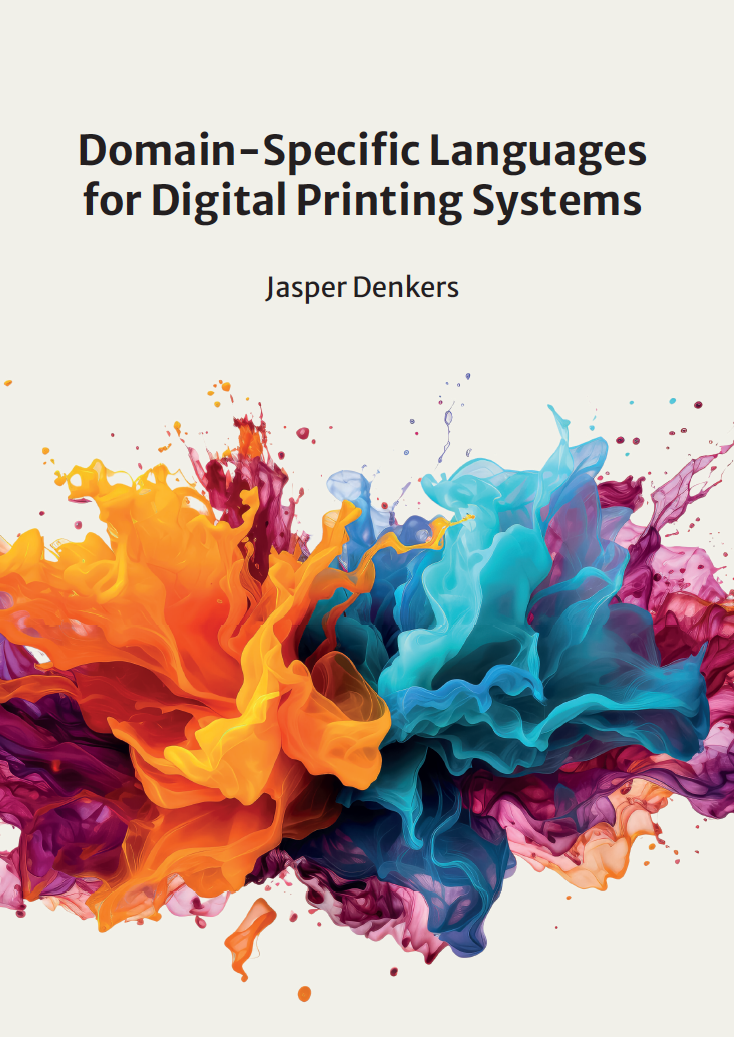
Domain-Specific Languages for Digital Printing Systems
Jasper Denkers
Date: Tue, October 01, 2024
Time: 15:00
Room: Senaatszaal, Auditorium
Note: This is a PhD defense. The candidate's talk starts at 14.30.
Tools used in software engineering often balance a tradeoff between generality and specificity. The most important tools in software engineering are programming languages, and the most common ones are General-Purpose Languages (GPLs). Because of their generality, GPLs can be used to develop many kinds of software. Domain-Specific Languages (DSLs) are a more specific counterpart; they are programming languages tailored to a specific domain. DSLs are not generally applicable but can be more effective for developing software within their particular domain.
DSLs can be beneficial if their benefits outweigh the investments. Advantages attributed to DSLs include improved software engineering productivity, improved automation possibilities, and enabling non-programmer domain experts to contribute to the software engineering process. Disadvantages attributed to DSLs include the costs of introducing and maintaining a DSL and dependency on skills. In practice, it is hard to predict whether a DSL will be beneficial.
Language workbenches are tools for developing and deploying DSLs. They aim to reduce the investment that is required for DSLs and to improve the usability of the created DSLs. By lowering the investment, language workbenches can improve the opportunity for DSLs to be effective. Although much academic work has been published about the underlying technology and concepts of language workbenches, there is little empirical evidence on the actual impact of language workbenches in practice.
In this dissertation, we contribute such empirical evidence on the creation and evaluation of DSLs that are developed with language workbenches. We do so by conducting case studies in an industrial setting. This is important, as such empirical evidence can help others to determine whether to adopt DSLs developed with language workbenches. In particular, we use and evaluate Spoofax, a language workbench developed at the Delft University of Technology.
The context of our work is Canon Production Printing, a digital printing systems manufacturing company. Canon Production Printing provides a good environment for evaluating DSLs as they have obtained extensive domain knowledge for complex domains like modeling behavior, performance, and physical aspects of printing systems. We develop and evaluate DSLs for two of such domains. First, we develop CSX, a new DSL for the domain of configuration spaces of digital printing systems. Second, we reimplement OIL, an existing DSL for control software based on state machines. In both cases, we compare the newly created DSL with the existing situation.
For both cases, we draw generally positive conclusions. For example, in the CSX project, the DSL enables the use of constraint-solving technology which aids automatic and accurate configuration of printing systems, which can ultimately improve the quality, performance, and usability of printing systems. In the OIL project, we found that Spoofax is more than adequate for developing a complex DSL with industrial requirements and we found indications that it is more productive to develop a DSL with Spoofax compared to using a GPL and available libraries.
Our extensive case studies at Canon Production Printing have taught us valuable lessons and insights. In particular, to make good on the promise of DSLs in industry, language workbenches need to improve in terms of the non-functional aspects. We expect that improving on, e.g., portability, usability, and documentation will improve the impact of Spoofax on industrial DSL development.
Reference
Jasper Denkers. Domain-Specific Languages for Digital Printing Systems. PhD thesis, TU Delft. October 2024.
Previous:
| Defense Jasper Denkers
Next:
Pedro Abreu | A Translation of OCaml GADTs into Coq